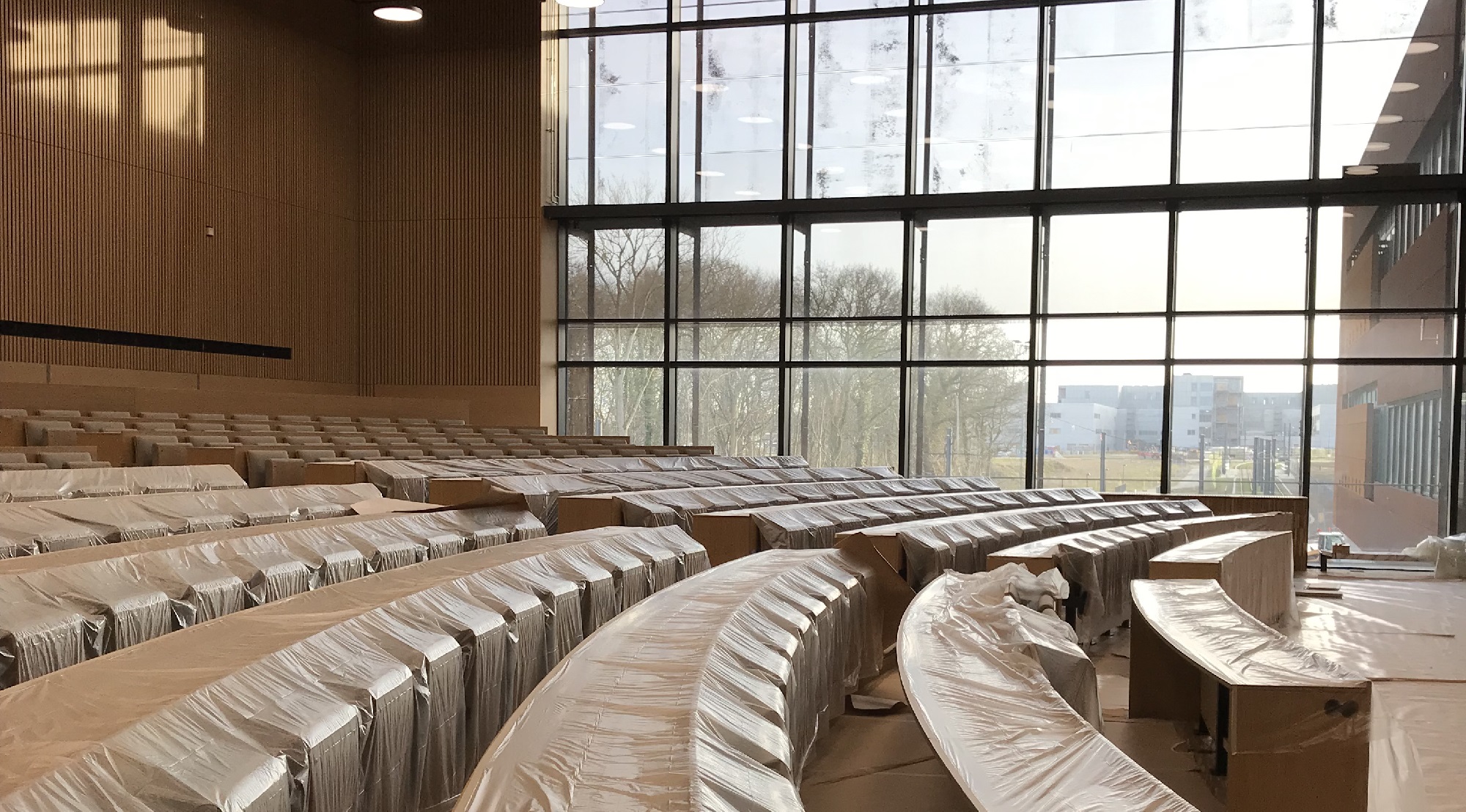
Design of classrooms in the new HEALTH building
Auditoriums, classrooms, and group rooms, workshop rooms, practice laboratories, and dissection hall. In the new HEALTH building, you will find a total of 55 brand new classrooms. Here you can see how they are distributed and arranged.
There are a total of 55 classrooms in the new HEALTH building.
Out of these, 42 are regular classrooms, which are shared and can be booked and used by anyone across SDU.
Additionally, there are 13 specialized classrooms, which are reserved for The Faculty of Health Sciences (HEALTH) and can only be booked and used by relevant users.
The classrooms are evenly distributed throughout the entire new building and are designed to accommodate different teaching methods.
Below you can see how the 55 classrooms are arranged and where they are located in the building.
Shared SDU classrooms:
- U240, U241, U250
- U320, U321, U322, U323, U324
- U360, U361, U362, U363
- U460, U461
Layout:
- 6 team rooms with group seating, accommodating 42 students + 1 instructor in each room.
- 8 team rooms with row seating, accommodating 40 students + 1 instructor in each room.
The two layouts were chosen based on didactic considerations and capacity requirements.
In addition, the expected use of each room has influenced the seating arrangement.
For example:
- Row seating in rooms with streaming equipment.
- Row seating in the room closest to "iLab South" to allow for small presentations before and/or during skills training.
- Group seating in 6 out of 14 team rooms to promote and support active teaching and learning.
Equipment:
- Chalkboard.
- In the 11 rooms without streaming equipment: Clip microphones and speakers.
- In the 3 rooms with streaming equipment: Tracking camera, ceiling microphones (used by both students and teachers), and speakers.
Examples of layouts:
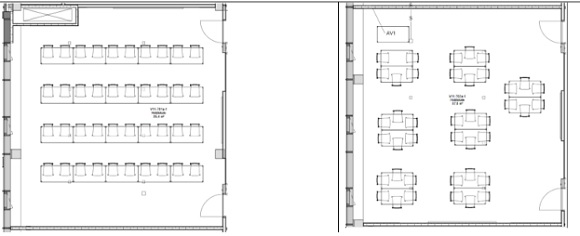
- Both rooms have group seating, accommodating 36 students + 1 teacher in each room.
- The rooms are equipped with fixed cabinets containing equipment specifically designed for skills training in the Clinical Skills Laboratory.
- This setup provides good conditions for group work during skills training.
- The rooms can also be used for other teaching, where they are particularly suitable for teaching that involves group work.
Equipment:
- 1 projector, screen (300x169).
- Audio/speakers.
- Chalkboard.
- Cabinets.
Examples of layouts:
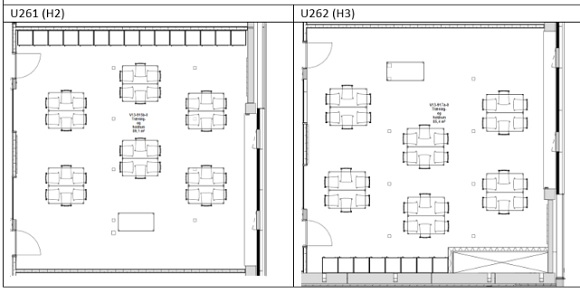
- Both rooms have a row arrangement, which accommodates 56 students in each room.
- The row arrangement was chosen based on didactic considerations and capacity needs.
- The room is well-suited for both lecture-style teaching and interactive presentation sessions.
- The even number of rows in the room promotes the possibility of group work, as students on every other row can easily turn around.
Equipment:
- Streaming equipment: Tracking camera, 2 x ceiling microphone, speakers.
- 1 projector, screen (300x169).
- Audio/speakers.
- Chalkboard.
Example of layout:
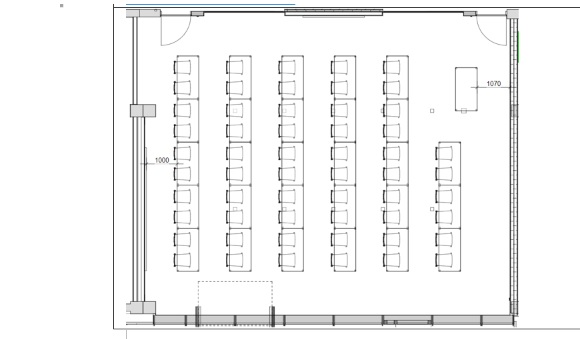
- Both rooms are furnished with a mix of row and group arrangements, accommodating 64 students in each room.
- The mixed layout is due, among other things, to the fixed column located in the center of each room, while also being chosen based on didactic considerations and capacity needs.
- The rooms can be used for lectures but are also ideal for group work, as the front rows can turn around and collaborate with the next row, while the other students are already placed in groups.
Equipment:
- 2 x projector, 2 x motorized screen (342x169).
- Chalkboard.
- In U221, the room without streaming equipment: Clip microphones and speakers.
- In U220, the room with streaming equipment: Tracking camera, ceiling microphones (used by both students and teachers) and speakers.
Examples of layout:
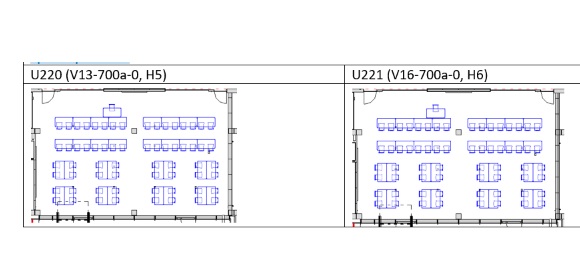
- The room has a flat floor and is furnished with round tables and a podium for the instructor.
- There is room for 160 students in the room.
- The round tables invite group work and discussions, facilitated by the instructor.
- The layout particularly encourages activity and feedback supported by the latest technology.
Equipment:
- Streaming equipment: Tracking camera, clip microphones for instructors, speakers.
- 2 x 165” LED screens.
- Audio/speakers.
- Wireless microphones for attendees (catchboxes, handheld).
- 9 mobile stations consisting of a wheeled stand with a screen that participants can connect to via HDMI. Ideal for group work, poster presentations, or other project work.
- 3 whiteboards on the wall under the screen.
- A number of mobile whiteboards.
Example of layout:
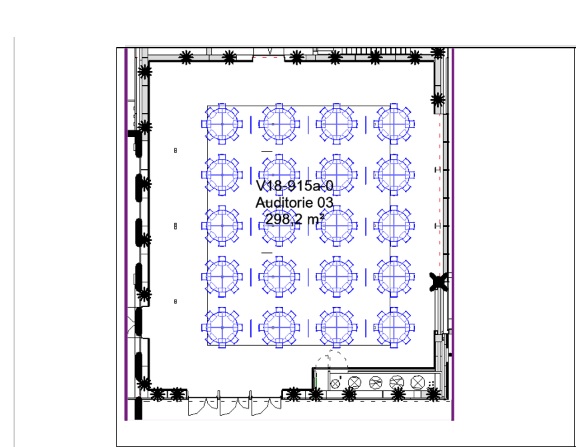
- The auditorium is arranged as a classic lecture hall with one row of seats on each level.
- There is room for 228 people + 2 wheelchair spaces.
- The room is expected to be primarily used for lectures.
- However, with two screens in the auditorium, there are also ample opportunities to incorporate digital elements that engage the students.
Equipment:
- Streaming equipment: Tracking camera, clip microphones for instructors, speakers.
- 2 x 165” LED screens.
- Chalkboards under the LED screens.
- Audio/speakers.
- Wireless microphones for attendees (catchboxes, handheld).
Example of layout:
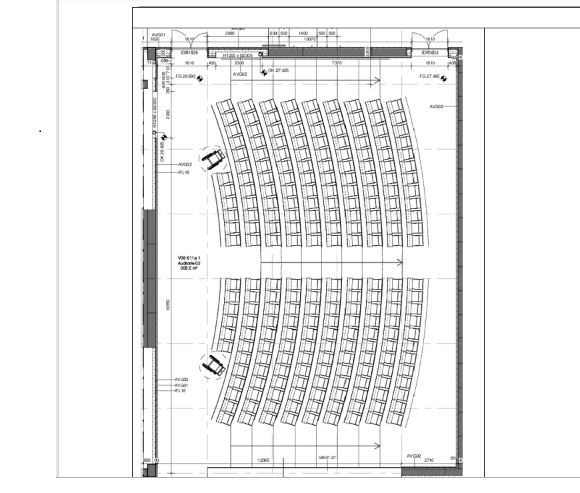
- The room is designed with two rows of chairs on each level, so that the front row on each level can turn around and do group work with those sitting on the back row.
- There is space for 189 people + 2 handicap seats.
- The room is particularly suitable for teaching methods such as "Team Based Learning" (TBL teaching) and other activities where students need to interact orally with each other.
Equipment:
- Streaming equipment: tracking camera, clip-on microphones for teachers, speakers.
- 2 x 165” LED screens.
- Chalkboards under the LED screens.
- Audio/speakers.
- Wireless microphones for audience members (catchboxes, handheld).
Example of layout:
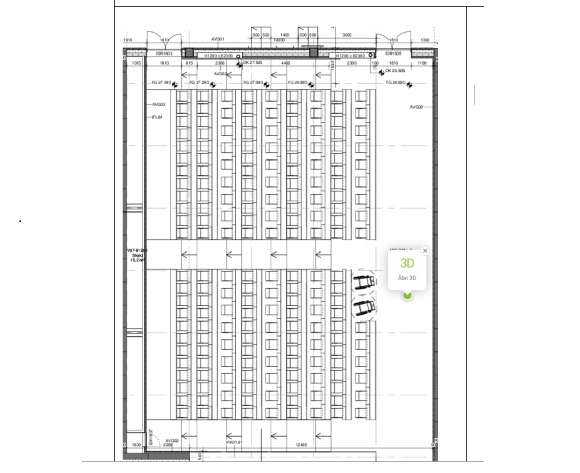
- U310, U311, U312
- U330, U331, U332, U333, U334, U335
Layout:
- The 9 group rooms are furnished with different setups, each accommodating up to 10 people.
- Through the installed screen, collaborative work on common projects and/or online/hybrid study group meetings can be conducted.
- The group rooms can also be used for teaching smaller groups.
Equipment:
- One 65” screen per room.
- Whiteboard.
Examples of layout:
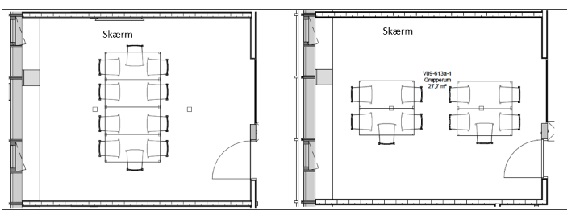
- The 2 group rooms are furnished with round and square group tables and can each accommodate 28 students.
- The group rooms can accommodate multiple smaller groups working together or teaching that primarily involves group work.
Equipment:
- 6 x mobile whiteboard.
Examples of layout:
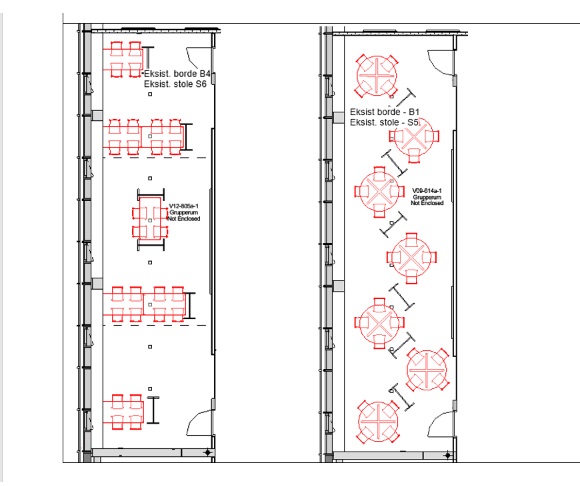
- U340, U341, U342, U343, U344, U345
Layout:
- The rooms are intended for physiology exercises.
- Outside the period with physiology exercises, the rooms can be used as group rooms.
- When the rooms function as group rooms, there is room for 12 students.
Equipment:
- Whiteboard.
- Curtains.
- Exercise mats.
- Fixed laboratory tables.
- Glove holders.
- Foldable table frame for when the room needs to change function between group room and exercise lab.
Examples of layout:
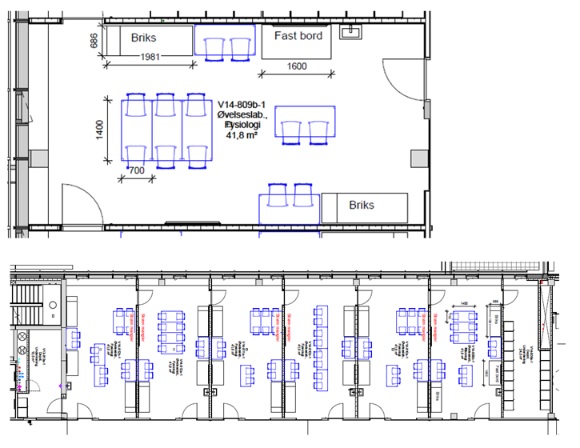
- The 2 group rooms are furnished with round and square group tables, respectively, and can each accommodate 28 students.
- The group rooms can accommodate multiple smaller groups working together or teaching where group work is primarily carried out.
Equipment:
- 5 x mobile whiteboard.
Examples of layout:
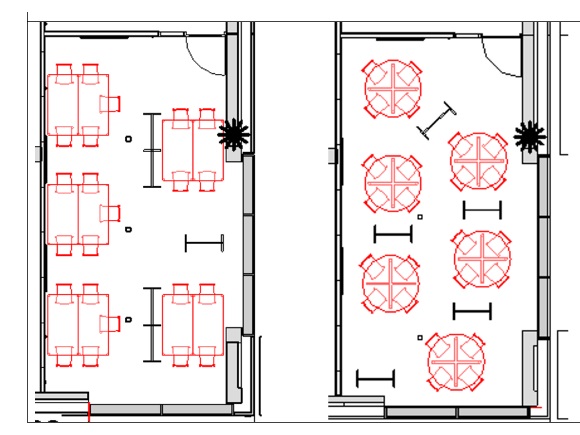
HEALTH-specific classrooms:
- The rooms are used for specific exercise sessions in the Medicine and Clinical Biomechanics programs.
- Outside of teaching periods, the rooms are used for research.
- The rooms are named SUND-large lab and SUND-small lab.
Layout:
- The two laboratories are equipped with fixed lab benches, consoles, and sinks.
Equiptment:
- Refrigerators.
- Freezers.
- Centrifuges.
- Flow hoods and incubators for cell culture.
- Whiteboard.
- Coat rack available outside the rooms.
Example of layout:
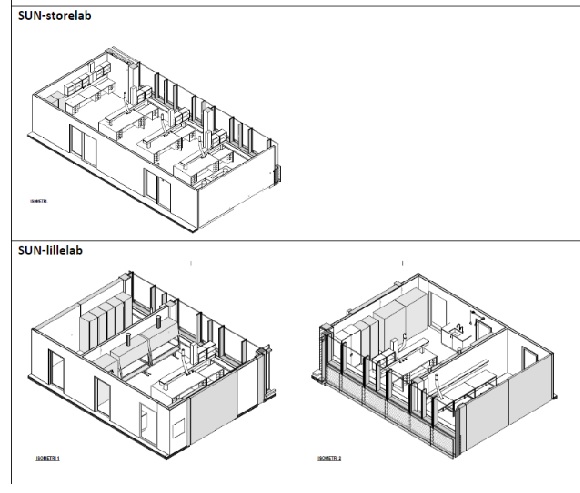
- U371, U373, U375, U377, U372, U374
Usage:
- The rooms are used for group instruction in anatomy in the Medicine and Clinical Biomechanics programs.
- The occupancy is so high that the rooms are currently not available for other purposes.
- Access to the rooms is limited to relevant users.
Layout:
- Each room contains 9 tables.
- The layout will be periodically adjusted by the users based on their needs. Examples of layout solutions can be seen in the drawings below.
- The rooms are equipped with suction and sinks to facilitate teaching with "wet preparations" (anatomy).
Equipment:
- Interactive boards including Mac mini.
- Whiteboard located on the side facing the windows.
Example of layout:
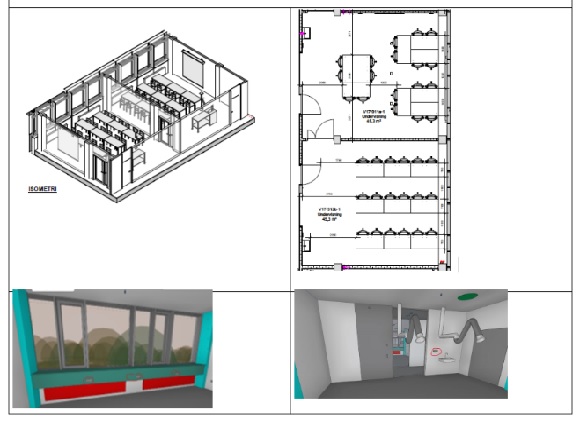
- The room is arranged in rows, providing space for 44 students.
- The row setup is chosen based on didactic considerations and capacity needs.
Equipment:
- iMac computer.
- 1 projector, projection screen (300x169).
- Audio/speakers.
- 48 x Microscopes.
- Whiteboard.
- Cabinets.
Example of layout:
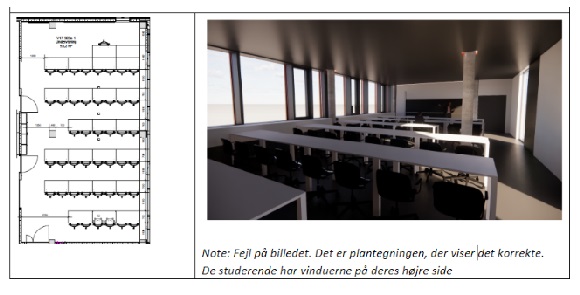
- The purpose of iLab South, as the workshop room is called, is to teach practical skill training in the health sciences programs.
- The room is primarily targeted towards the Medicine and Clinical Biomechanics programs. However, it can also be used by other programs that require workbenches for practical skill training.
- Access to the room is limited to relevant users.
Layout:
- The room is designed with a focus on technology that supports practical skill training instruction.
- The pedagogical principles for modern practical skill training instruction are described in four teaching scenarios, with teaching scenario 1 expected to be the primary teaching method in iLab South.
- However, all 4 teaching scenarios are made possible:
- Teaching with PowerPoint and video
- Group work with video
- Ongoing supervision with video
- Independent practice with video
The setup also provides students with a conducive environment to practice practical skills, with the ability to review instructional videos on the screens in the room.
Equipment:
- 6 TV screens including Apple TV.
- iMac computer.
- Creston control panel.
- Instructor iPad.
- Audio/speakers.
- Microphones/headsets.
- 22 workbenches.
- 25 chairs + chair trolley.
- Instructor's desk.
- 5 cabinets.
- Keybox (iPad, keys for cabinets, microphones, etc.).
- Training mats + hooks for hanging.
- Hand sanitizer dispensers.
Example of layout:

- The room is dedicated to dissection teaching in the Medicine and Clinical Biomechanics programs.
- It is also used for postgraduate/A-courses.
- Access to the room is limited to relevant users.
Layout:
- The room is equipped with 8 fixed dissection tables, a number of cabinets, and sinks.
Equipment:
- 4 screens
Example of layout:
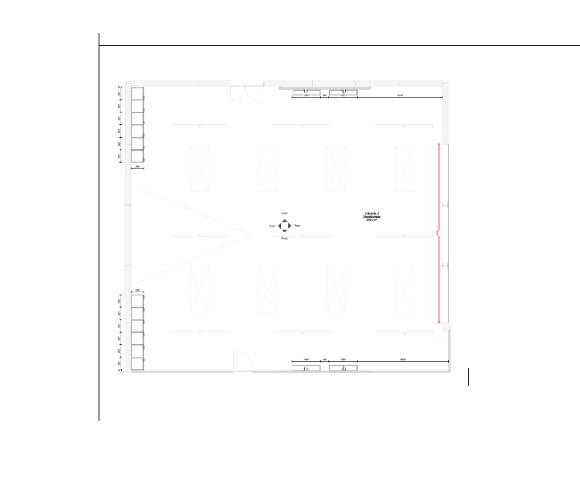
- The study halls replace what was previously referred to as "Tørsalen."
- The study halls are intended for students to engage in group work or individually immerse themselves in their studies.
- The study halls are divided into an open anatomy room and a closed anatomy room, collectively referred to as the Museum.
- While all students can use the open anatomy room, only students from the Medicine and Clinical Biomechanics programs have access to the closed anatomy room. Otherwise, access is granted by special arrangement.
Layout and equipment:
- Desks with accompanying chairs.
- Glass cabinets with anatomical specimens.
Examples of layout:
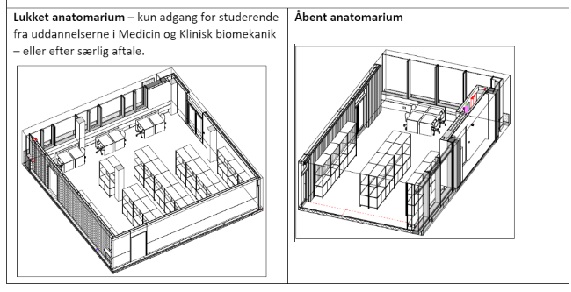
Booking of classrooms
- The classrooms have been made available for booking with reservations from September 1st onwards.
- However, in line with SDU's guidelines, currently only schedulers can book the classrooms.
- From June 26th, they will be released for booking by everyone else.
Find your way with SDU Maps
All classrooms in the new HEALTH building can now be located in SDU Maps.